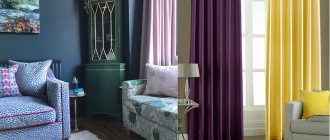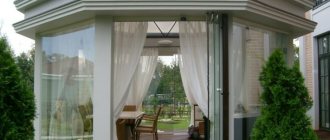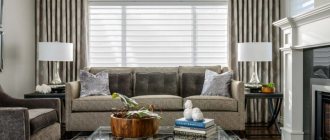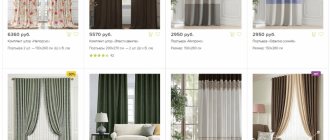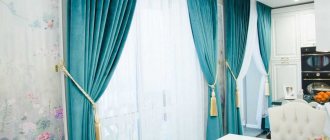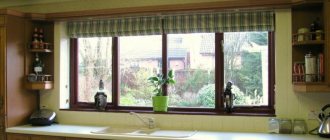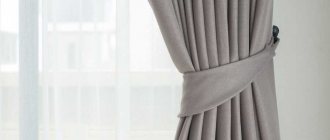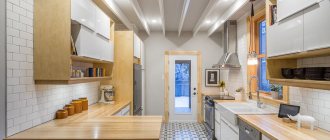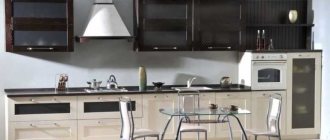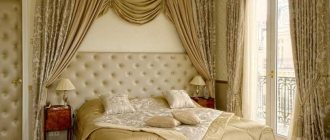Classic
They have been used for quite a long time, and every year they become more and more popular. First of all, this is due to the fact that minimalism and loft are coming back into fashion, which implies the absence of unnecessary details.
In fact, every home once had this type of curtain. Its advantage is that it fits perfectly into any style and interior. For living rooms, it is best to use more delicate, warm shades; you can add voluminous, intricate patterns.
For bedrooms, it is best to use plain, calm shades such as beige, turquoise, etc. For a children's room, it is recommended to use curtains in original colors. This will spur the child to creativity and will lift his spirits.
The classic type of curtains can be hung not only in the apartment, but also in the office. They will go perfectly with business style. Types of curtain rods are divided into several types: by fastening, by material, by appearance.
Curtain design: what types of curtains are there?
Curtains can be of different lengths. Curtains up to the window sill should lightly touch it. They are used on windows in niches or on horizontal windows. The curtains below the window sill end above the radiator. They may look sloppy when pulled apart, so you need to use ties or holders. Floor-length curtains can even fall in folds onto the floor.
Cafe style curtains only hide the bottom of the window. They can be combined with long curtains and lambrequins. These curtains can be hung inside or outside the window ledge, on a rod or rod. The upper edge can be trimmed with braid, drawstring, loops, and ribbons.
Screen curtains are hung from drawstrings and rods at the top and bottom.
Hourglass curtains are a type of screen curtain. This curtain is pulled together in the center, forming an hourglass-shaped drapery.
Curtains with ties look beautiful. They constantly cover part of the window. Such curtains look elegant, and to change their length, you only need to adjust the ties. Supporting stripes can be tied into romantic bows or decorated in the form of belts fastened with buttons at the base.
The bottom edge of the curtains can be trimmed with ruffles.
Scalloped curtains have a special braid to form vertical gathers. The edges may be decorated with frills.
Austrian curtains form graceful scallops when raised, and hang straight when lowered, retaining only a few soft folds along the bottom edge. Such curtains are controlled using a set of cords threaded through loops or rings on the reverse side.
Italian curtains are a cross between a curtain with ties and a curtain with scallops. The fixed heads of the curtains are sewn in the center, and the panels are constantly drawn back using cords passed through rings on the wrong side. The top edge is clearly shaped and radial, French or cylindrical pleats can be used.
Slouchy curtains look lush and add grace and elegance. The billowing shape is created by tightly tying the fabric in one or more places and then straightening the overlap. Lightweight fabrics hang almost straight, flaring slightly just above the ties. Heavy fabrics take on a more voluminous appearance. The expressiveness of the forms is emphasized with the help of thin papyrus paper, which is used to stuff the overlap.
Straight curtains are suitable for decorating a small window in a room where you want to keep a simple style. Such simple curtains are well suited for a child's room. Usually they are decorated with ties made from the main or finishing fabric, woven from cords, and tassels. Wall hooks or holders are also used.
Curtains can be lined to protect the fabric from fading in the sun. Also, thanks to the lining, the curtains drape better. You can use a lining made of contrasting patterned fabric or fabric that matches the curtain. Curtains with soft padding between the curtain fabric and the lining will hang beautifully and will provide reliable isolation of rooms from unwanted light from the window.
The luxurious combination of different fabrics in this room creates a single ensemble. The upholstery of the pillows resembles the lining fabric, but has a different color scheme.
Upholstery fabric is successfully used for lining curtains and sofa cushions.
The top edge of the curtains can be designed differently. It can be assembled in various folds.
Elegant curtains gathered in triple folds form a goblet pattern. Tassels keep the curtains open at all times to highlight the height of the window.
The simplest one is a drawstring - this is the hemmed top edge of the curtain into which the cornice is inserted.
The most common decoration for curtains is a lambrequin, which is located in front of the curtain and gives the window a decorative finish, hiding the cornice and the top of the curtain. With its help, you can change the proportions of the window, making it visually taller or narrower. Lambrequins can be straight or defined, and the bottom edge can be trimmed with braid or fringe.
The lambrequin can also be made of wood - wooden frames are covered with fabric or painted or covered with wallpaper.
Draperies add special splendor to the window decor. A garland is an elaborate drapery in front of a curtain. Strict garlands are suitable for high windows and long curtains. Smaller garlands look good on a small window.
Trains are pieces of fabric that hang down either side of a window or wrapped around a curtain rod. The window can be decorated with a light blanket, shawl, transparent fabric or fabric with fringe, lace or piping. This design is elegant, but not practical.
A floral border in pastel colors enlivens the long train of white muslin.
Crossing and other improvised draperies usually have a fixed position. Light transparent fabrics are chosen for them. Crossed draperies are created by joining two panels along the top edge and are suitable for narrow windows. Both pieces of fabric are pulled to opposite sides of the window so that they form two gracefully curved trains. If the curved edge is longer than the opposite side, the bottom edge will hang straight when the draperies are secured to the sides of the window.
The drapery can be complemented with a border made of contrasting fabric or the fabric can be tied around the holder with a knot, forming a kind of rosette.
Traditionally, curtains are hung on a curtain rod using hooks and tape, which is sewn to the top edge of the curtain from the wrong side. Braid can come in a variety of widths and styles, which creates different folds by pulling the cords of the braid. Triple and cylindrical folds are suitable for long curtains, radial - for short ones.
But there are many other options for processing the top edge of curtains. You can hang them using loops, rings, and ribbons that are tied into bows on the cornice.
Ties can play up the color nuances of the fabric, while a wide border and contrasting fabric ties provide a nice finish. The ties can be long and narrow or short and wide.
Buttons are another original decoration for the top edge of the curtains. They can be covered with fabric (the same as curtains or contrasting), of different colors and sizes, shiny copper, wooden. Buttons are used to decorate the loops and serve a purely decorative role. As a rule, buttons are half the width of the buttonhole.
Curtains with eyelets look beautiful. Rings of different diameters are inserted into the hole, into which the cornice is threaded. You can also insert hooks into the rings and then hang them on the cornice.
Accessories for curtains amaze with their beauty and variety. These are, first of all, curtain rods, as well as holders, hooks, ties, and sockets. Decorative hooks and holders in the form of cones and round handles are suitable for securing all types of curtains.
Braided ties highlight the shape of the curtains. They are made from several strips of fabric sewn into a tube shape and filled with soft padding, or from thick cords woven together. Plain curtains will complement contrasting or patterned ties.
Fabrics of different colors with the same pattern are successfully combined here. The solid color lining and ties stand out against the yellow roses.
Curtain ties can be decorated with velvet roses. Roses can be placed on the drapery of a garland or attached on top of a folded lambrequin.
The holders are attached to both sides of the window. They can be made of metal, wood, plastic or rubber. The holder's termination or hook prevents the curtains from sliding off.
There are many design options for curtains and the possible combinations of different details are endless.
Domadiz.ru – Interior design and renovation
Subscribe to “DOMADIZ.ru” on social networks to always be aware of new articles!
Follow @domadiz Subscribe Subscribe to news Like Pinterest
You might be interested
On this topic:
- Caring for curtains. How to wash curtains
- How to choose curtains and curtains
Austrian
Austrian curtains are notable for the fact that they are a canvas assembled into beautiful horizontal folds.
To form these folds, a lace or a plastic stick is used. The mechanism is exactly the same as that of blinds, only in the upper position it is necessary to fix the canvas manually. If desired, Austrian curtains can be opened.
The most popular models are those made of silk or cambric. Fastening curtains in this case can be of several types, as in the previous case.
Vertical curtains
Most often, pleated curtains are made with horizontal folds, but sometimes vertical folds are also made. They also use pleated curtain fabric treated with special impregnation. Impregnation protects the material from water and from rapid fading from ultraviolet radiation. The width of vertical folds is usually 1-5 cm.
French
The French made a huge contribution to the development of most styles that are now very popular. All products and ideas from this country are distinguished by sophistication and delicacy, including curtains.
French curtains have a large number of subtypes, which allows you to choose the most suitable option for a specific room.
Note!
- Light green curtains - 120 photos of the most beautiful design and interior design options
- Ready-made curtains - how not to make a mistake with your choice? TOP 100 photos of the best new designs
Japanese curtains in the interior: bedrooms, kitchens, living rooms. 90 photos of the best new designs
Most often they are placed in the living room or bedroom. This is due to the fact that they are made of a fairly dense material that can protect from excess sunlight and dust.
How to attach pleated
The smaller the pleated curtain and the lighter the material, the easier the structure is to secure. Cornices and guides are attached through special brackets either directly to the frames or to the wall - inside or outside the window opening. There are options for attaching pleated curtains directly to the glass.
In the glazing bead
In this case, window sill and/or ceiling brackets are used.
They are fixed at a distance of a maximum of 3 cm from the glass, in the case of a “day-night” assembly - min 5 cm. As a result, only the glass and glazing beads are closed. For correct marking, so-called installation stops. The brackets are screwed to the walls inside the window opening.
After measuring the width of the canvas along the stop on the cornice, the cutting location is drawn. The outer edges of the stops are aligned with the width of the curtain. After this, the support is secured with screws. A cornice is inserted into the upper brackets, and the brackets below are placed on already fixed supports.
As a result, the pleated curtain covers only the glass of the window, slightly catching the glazing beads, and the frame remains open.
In the opening to the frame
With this method, there is no gap through which light can penetrate. In this case, the canvas extends beyond the glass (to the frame) by 1.5-2 cm on each side.
Brackets with clips for this design are fixed to the walls. At the same time, the window sill remains open.
Through the opening on the wall
This method is used if the window frame is wider than 5 cm or you need to cover the window sill, frame, entire slope, and window handles with a curtain. This is still the same installation on the frame, only the ceiling brackets are screwed to the slope from above.
Sash mounting
With this method of fastening, drilling the walls is not required. The brackets are attached to the sashes separately. Sometimes fasteners to the window sill are used, then the curtain support can be screwed to it.
Do not trust claims that drilling harms frames. The fact is that all PVC profiles are hollow inside, and drilling on one side does not in any way violate the overall tightness of the frame; neither cold air nor moisture will penetrate through it from the outside.
Bamboo
One of the types of roller blinds. Its peculiarity is that it is completely natural, made from bamboo. This type is made entirely by hand, which adds value.
Bamboo stems are used as the main material. The disadvantage of this type of curtains is the small number of variations available on sale. In addition, the appearance, as a rule, cannot be edited in any way, unlike classic paintings.
However, they are highly resistant to virtually any climate and provide excellent protection from the sun and dust. If desired, they can be repainted in any color; already painted models can also be found on sale. They are very easy to care for; just wipe with a damp cloth to remove dust.
Types of sliding curtains
The sliding type of curtains involves opening the curtains to the sides of the window. As a rule, the upper part of such curtains is fixed vertically to the cornice. Sliding curtains can be adjusted in width and height.
Classic straight curtains
This type of curtains is most widespread. Classic straight curtains consist of thick curtains and light curtains fixed vertically to the eaves. Lined curtains can be used.
Crossed curtains
The panels of this type of curtains are fixed on opposite sides of the cornice. The fabric of the curtains goes cross to cross. Such curtains can consist of either two halves or one sheet that is thrown over the cornice.
Cafe curtains
This type of curtain refers to short curtains, the length of which does not fall below the top edge of the window sill. Cafe curtains are attached to a cornice or bar located in the middle of the window. The fabric can be either dense or transparent. In addition, various decorative elements can be used - buttons, loops, eyelets, etc. The height of the cafe curtains allows light to enter the window even when closed.
Curtains with lambrequins
From the name it is clear that this type of curtain is supplemented with decorative elements - lambrequins. Lambrequins can be attached directly to the curtain fabric or have independent fastening elements. Lambrequins can have both a hard and soft structure. As the basis of a rigid structure, you can use wooden slats, and for soft braiding. For curtains with lambrequins, it is optimal to use a rail cornice, consisting of several rows for fastening the canvases. This type of curtains is used in classic interiors.
Japanese curtains
This type of curtains has a rigid structure. The curtain panels are fixed to the frame. Usually the width of one curtain does not exceed 1 meter. Japanese curtains are not adjustable in height, but move along the width of the window. Such curtains are very similar to screens that are used as light partitions in a room. The use of Japanese curtains is appropriate in interiors in Japanese style and minimalist style
Thread curtains (muslin)
This type of curtain is made of heavy silky threads. Due to the weight, the threads do not get tangled. Thread curtains can also be used to decorate doors or zoning space in the interior
Photo curtains
This is a fairly new type of curtain for the Russian market. They are made using dense, light-proof fabrics, such as blackout or satinette. For those who like to sleep in the morning, these curtains will be a good surprise. The design is applied to the fabric using digital printing. Therefore, to order, you can make almost any design you like on your curtains. In addition, manufacturers make bed linen and tablecloths with photo-printed designs, which makes it possible to tie together the composition in the interior. The curtains open to the sides like regular straight curtains.
Rolled
The photo of the best types of curtains shows that roller types are very popular. This is due to the fact that with their help you can greatly save free space, while they can provide excellent protection from the sun and dust. There are only 2 types: classic (width no more than 1.8 m) and luxury (width is individual).
Classic ones can be found on sale in a wide range; they are suitable for most windows. Luxury is designed for large windows, for which it is difficult to choose curtains. As a rule, they are ordered individually from the manufacturer according to their own window parameters.
Curtains for decoration
I have identified these curtains as a separate type because they do not serve to decorate windows, but to decorate other interior elements.
Curtains for doors and doorways
Curtains for doors can serve several functions
- decorative function - in this case, the curtains simply decorate the doorway and, depending on the style, can make your interior more formal or, conversely, more homely and cozy.
- the function of a partition or curtain between rooms or zones in a room. In this case, the curtain performs the function of a door - it closes the door frame and separates the rooms.
Door curtains can be attached to the cornice above the doorway or directly to the door. Attaching curtains to a door is usually used on doors with glass. An example of such fastening was presented above when describing stained glass curtains.
Canopy curtains
The word canopy comes from the Italian baldacchino, which meant “silk fabric from Baghdad.” The canopy appeared in the ancient East. Then an umbrella made of fabric was worn over the king, which protected him from the sun and prying eyes. Later, the umbrella turned into a portable throne or bed, protected by fabric around the perimeter. Indoors, the canopy was used as a curtain over the throne or ceremonial seat. Later the canopy found itself in the bedroom. In Rus', our ancestors used a canopy to protect a baby's sleeping place from drafts and insects - hanging the fabric over the baby's cradle.
How to choose the right fabric
It is necessary to choose a fabric first of all based on the specific room in which the curtains will be located.
If this is a kitchen, it is better to give preference to light, translucent options. This is due to the fact that the kitchen, as a rule, is not located on the sunny side; there is no need for constant protection from sunlight.
Denser options are ideal for the living room and bedrooms, where it is necessary to completely isolate the room from light.
Pleated blinds curtains
This option is characterized by a frequent “accordion”, assembled in such a way that from a distance it looks like ordinary horizontally oriented blinds. And only up close you can see that the canvas consists of continuous material, and not separate strips.
Without any problems, such curtains can be attached to both a wooden window and a PVC window, regardless of its shape. Another interesting nuance is that “accordions” look good both in 1-tone design and with a pattern. In any case, such curtains do an excellent job of protecting from the scorching sun.
Photos of modern curtains
+1
Types of materials
Below is a description of the materials from which modern manufacturers make canvases.
Fabrics for curtains
Curtain fabrics should be dense enough to not allow sunlight to pass through and flow beautifully, forming large folds.
Blackout
This type of fabric consists of two layers. On the side of the room there is a decorative material that fits well into a specific interior, and on the reverse side there is a light-proof and reflective layer. Such curtains will protect the room not only from the penetration of unwanted sunlight, but also from excessive heat.
Velvet
Velvet curtains look very elegant and rich. It is not for nothing that curtains on the windows of royal persons were usually made of velvet. Velvet can be used either alone or with a scattering of pearls or beads, and can be complemented with embroidered patterns or tassels.
Jacquard
Produced since the beginning of the 19th century, it is a very durable fabric that is not subject to abrasion or deformation during washing. It is a material densely embroidered with all kinds of patterns. Jacquard curtains are not cheap, because the production of such fabric is a very labor-intensive and expensive process.
This type of curtains was returned to the interior by modern designers at the peak of the popularity of environmentally friendly materials, as they relate to natural fabrics. Fits well into many modern interiors without overloading them with a large number of patterns.
Atlas
It is distinguished by its special chic and nobility. Satin canvases shine when the angle of refraction of light changes, which fascinates and attracts the eyes of household members and guests.
Taffeta
It was widely used in ancient Persia and Byzantium. It is obtained by weaving artificial and natural fibers. Like satin, it has a charming shine. Very durable and strong fabric, which also has water-repellent properties.
Gozhka
Refers to natural fabrics. It has a rough texture with a cross-shaped weave of threads. This material, modest in appearance, fits perfectly into eco, loft, and minimalist interiors; when combined with other types of fabrics, it will suit any modern design.
